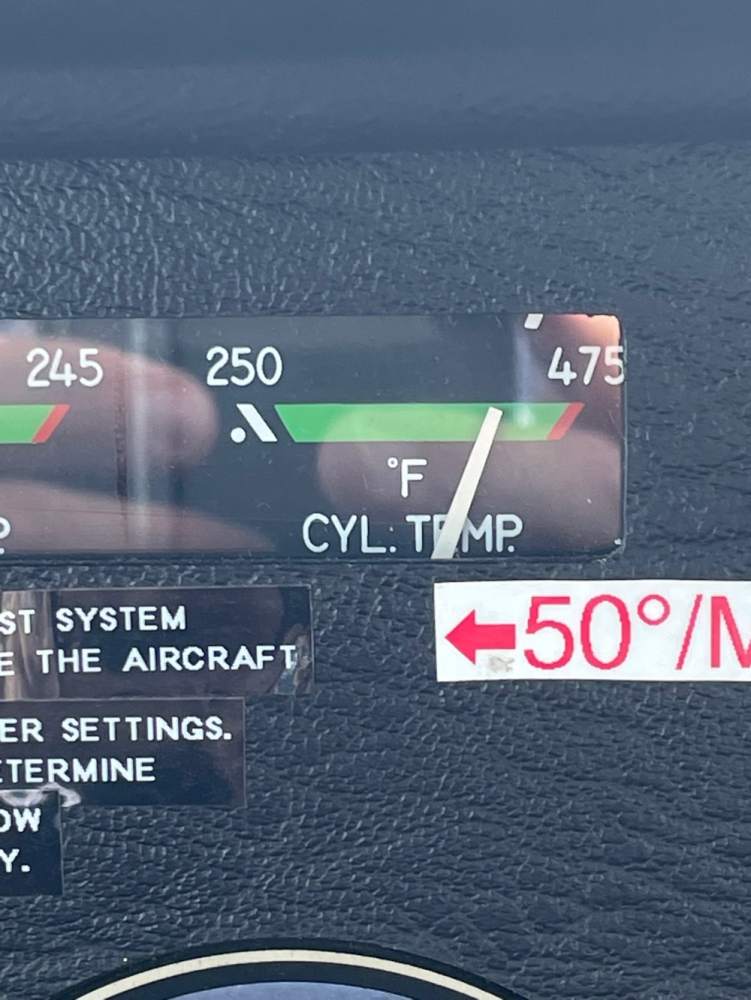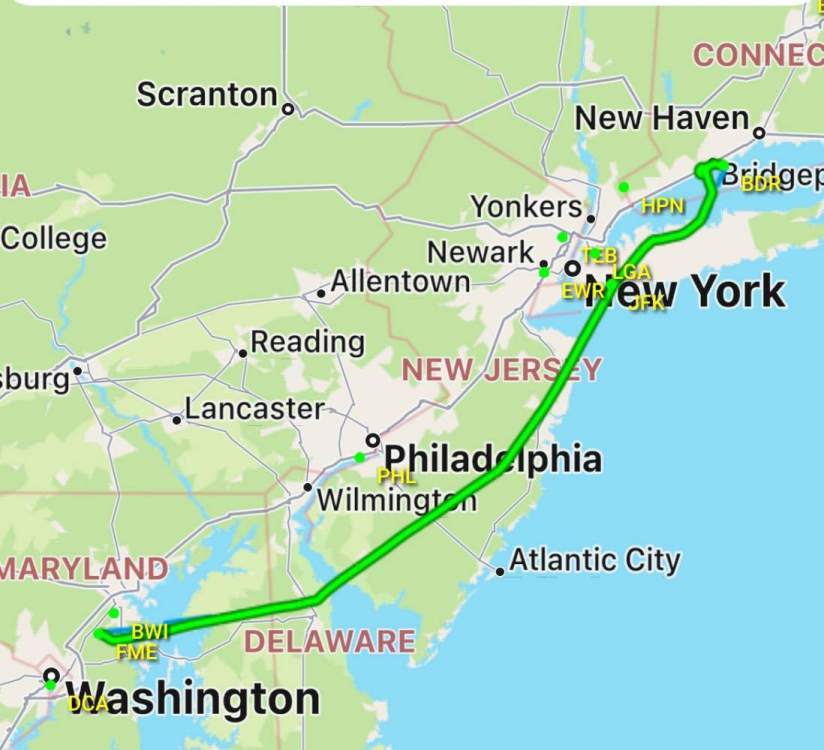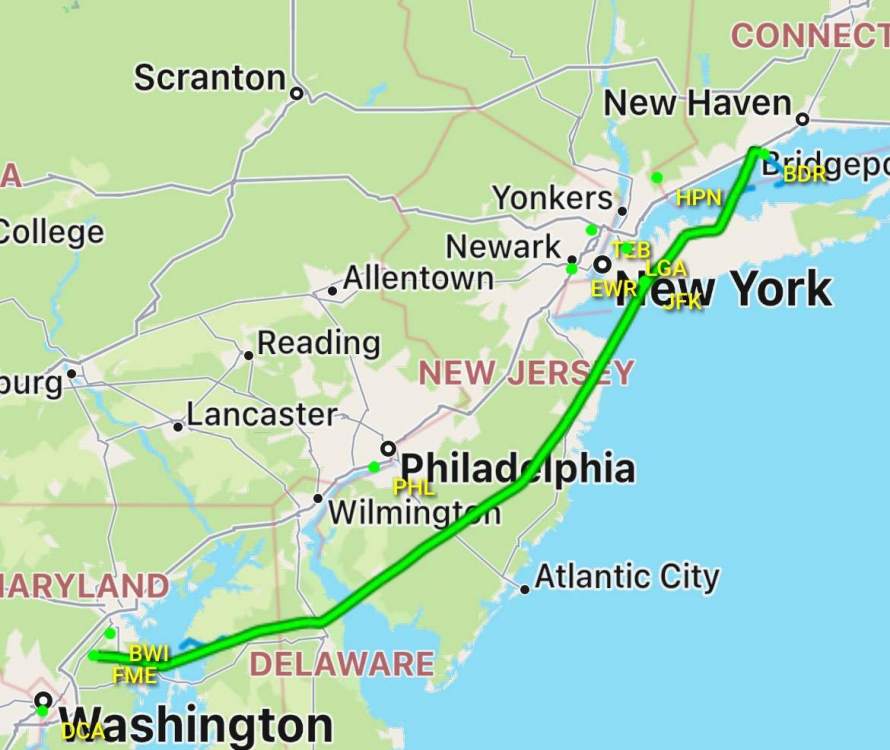
will1874
-
Posts
37 -
Joined
-
Last visited
Content Type
Profiles
Forums
Blogs
Gallery
Downloads
Media Demo
Events
Posts posted by will1874
-
-
He heard the controller asking Delta if he needed to remain on the runway, and heard Delta say "Ugh"... If he did not make the connection his SA was so bad, he needed to return to the gate.
It's a shame they didn't go back. It would be valuable to have that CVR.
Sent from my iPhone using Tapatalk-
 1
1
-
-
If I had a near ground collision through my error, I would be on the phone to the Fight Ops Duty Pilot so the company is in the loop before I took off and let them make the decision. Worst thing you can do is let your Chief Pilot get blind sided.
I got the impression by the ATC audio that they weren't aware that they were in danger of a collision. The captain was confused only about being "cleared to cross"
Sent from my iPhone using Tapatalk -
1 hour ago, Will.iam said:
A little more data would help. You say ROP but are you 50 degrees ROP 100 degrees ROP or full rich? 7000ft I’m guessing 23” or 24” MP but would be better to post what your gauges indicated.
My initial guess would be to double check your baffling to make sure there is not a gap somewhere. If there is not an issue there then either run more rich - cool with fuel or run LOP but I wouldn’t do LOP until you have an engine monitor that you can verify all cylinders are not too hot. Even right now you have no idea what temperature the other 3 cylinders are at. Maybe one of the other ones are at redline already?
and yes in summer if I’m pushing the motor hard I’ll open the cowl flaps in trail to keep my cht’s below 385 (my personal limit)Yes, the manifold pressure was around 23"
I agree about the engine monitor. It was supposed to be installed at the last annual...but there were some communication issues (to put it mildly) so that didn't happen.
-
 1
1
-
-
2 hours ago, ArtVandelay said:
Altitude?
I fly higher in summer if possible (>8000’) to get to cooler and smoother air.
What’s the 50° placard mean?I was at 7000 feet.
I don't have any idea. One of the previous owners had an affinity for label makers… My panel is covered in homemade placards.
-
Cruising yesterday at 7,000' I don't have an engine monitor. But I'm running ROP. WOT and 2300 RPM. OAT is 15°-18°C. Cowl flaps are closed when this picture was taken.

Nope...don't like that. I went the rest of the way with the cowl flaps open halfway.
This is my first summer of ownership so I'm not sure what normal is during these warm months.
What's everyone else doing with their cowl flaps in the heat of August?
(I do have plans to install an engine monitor soon)
-
10 hours ago, takair said:
Will, Sounds like you are on the road with this problem. Does the plane have a voltmeter? If so, you can get a sense of what’s going on by reading that. Typically you want to be near 14….but can manage on less, as long as it’s charging somewhat (something greater than 12….under reasonable load). If you don’t have one, you might temporarily get by with a cigarette lighter style that you can pick up locally. That way you can at least do a local flight to see what the problem looks like after things cool down. It might be your ticket home….VFR of course. You might also play with electrical load to see if you can get it lower and still get home….
I do have the simple cigarette lighter voltmeter. And we were bouncing between 14 and 13.8. I'll probably just bring it to a good shop on the way home.
-
 1
1
-
-
9 hours ago, takair said:
Will, Sounds like you are on the road with this problem. Does the plane have a voltmeter? If so, you can get a sense of what’s going on by reading that. Typically you want to be near 14….but can manage on less, as long as it’s charging somewhat (something greater than 12….under reasonable load). If you don’t have one, you might temporarily get by with a cigarette lighter style that you can pick up locally. That way you can at least do a local flight to see what the problem looks like after things cool down. It might be your ticket home….VFR of course. You might also play with electrical load to see if you can get it lower and still get home….
I do have the simple cigarette lighter voltmeter. And we were bouncing between 14 and 13.8. I'll probably just bring it to a good shop on the way home.
-
18 minutes ago, N201MKTurbo said:
The diodes rarely fail, but the diode connections do fail from vibration. Doesn’t make much difference unless you are prone to fixing things. Ive been able to resolder the diodes a few times and fix that problem.
Do you mean I just need a new alternator unless I'm good at fixing things? (I'm not prone to fixing anything).
-
Hello all,
I took the family on their very first cross-country adventure today. Left KBDR for KFCI. That leg was uneventful and everyone loved it. Got out at KFCI, fueled up, ate at the restaurant, and got back at it. Next leg was KFCI to KHXD.
It was hot. Probably close to 90 on the ramp. Took off and headed south. Climbed up to 8000' I kept noticing a very faint whine...almost alternating like the gear warning but not nearly that loud. I thought it must be some sort of feedback from a headset or radio or something. Once we leveled off and reduced RPM for cruise I started trying to troubleshoot. Then I saw it. Very faintly the HIGH LOW VOLTAGE warning light was flickering. Not flashing like when you're not producing any electricity. I reset the alternator field CB. Whine immediately went away when I pulled it. Came back when I reset the CB. I decided to divert to KRDU. Eventually the flickering stopped. Seemed like the faint whine did too. But it was tough to tell while we were getting the stuffing beat out of us on the way down into RDU.
Like I said it was hot. The hottest cylinder head temps I've seen. Still in the green, but near the top of the gauge. (I do not have an engine monitor).
is it possible the alternator overheated?
-
12 hours ago, jetdriven said:
I own a shop at Gaithersburg which is the next town over, give me a call 484-435
97
76
Thank you so much for the offer! I got your text and I'll reach out a little later this morning.
-Will
-
Descending into Tipton (KFME, Fort Meade, MD) Wednesday and the HI LOW VOLTAGE warning light started flashing. I was close enough that I just continued to Tipton. It was only another 12 minutes-ish. Clearly an alternator issue. Hopefully it's something simple. The alternator only has a little more than 300 hours on it. Hoping it's just a broken wire.
But now the airplane is AOG there. I had to go fly the big airplane that pays for the little airplane so I haven't done anything as far as troubleshooting so far. It's only been three days, but no luck getting the shop on the field to respond to requests for assistance.
I got a pretty good briefing on what to look for initially from the folks at Weber Aircraft at KLNS. But the airplane is fairly new to me. I've never removed the cowling. Taking each half off seems simple enough, but I'm not so sure about getting it back on by myself.
Do any of you who live in the Baltimore / DC area have any recommendations on an A&P that will travel? I'm more than happy to compensate anyone who is willing to help.
Feel free to text me at
eight six oh, 6 one four, sixty-nine 80.
TIA
-Will
-
Sent you a PM
Sent from my iPhone using Tapatalk -
My POH makes no mention of extending flaps for a pre-flight inspection. Does anyone do it? Any reason NOT to do it?
-
Years ago when I worked for Sikorsky Aircraft I flew this route many times to DC from just N of BDR. I know staying high was a stated goal for Will 1874, but just once he should fly the NY exclusion on the Hudson River below the Class B. No need to talk to controls. Just self announce on the common frequency entering and exiting the exclusion. The views of the city and the surrounding are are are worth it and just it's good fun.
I definitely plan on this as soon as I find a day that's not so bumpy!
Sent from my iPhone using Tapatalk -
1 hour ago, DXB said:
I fly in this area all the time. Whether you go VFR or IFR, they'll put you at whatever altitude they want you at in the NYC and Philly class Bs - in my experience it's not that different on VFR flight following vs. IFR. If you want max discretion, go VFR and stay clear of Bravo airspace until you get near Baltimore / SFRA. Flying in the SFRA is no big deal when VFR. All else being equal, I tend to enter and exit the SFRA IFR just 'cause I'm lazy -I don't want to waste mental energy thinking about SFRA flight plan entering through Wooly gate blah blah blah....
so you'll file an IFR to a fix just to get out? Like I could file IFR to say EMI and just say in the remarks that it's just for exiting the SFRA?
-
Hello all,
I'd like thoughts / advice on the following:
mission: KBDR - KFME (Bridgeport, CT to Tipton field just south of Baltimore, in the D.C. SFRA)
The last two two times I flew it I filed IFR and I don't like the routing I get (see below) or the altitudes they assign (too low). I'd prefer to go at 8,000-9,000 feet for better rides, and (as I'm new to the airplane) more time / options if there's an engine issue.
I'm considering going VFR next time to stay west of New York / Philly. I've been in the airline world for the last 20+ years and don't recall ever flying VFR through class B. Do any of you do this routinely?
I've completed the DC SFRA training but have yet to operate VFR in that airspace.
I welcome your suggestions.
Thanks,Will
-
Welcome! Are you a SW pilot?
Yessir
Sent from my iPhone using Tapatalk -
If you call the destination city office, in particular Enterprise you can sometimes find a car they want back that went out bound on a one-way and they will give you a great rate to get it back to them. I've hit the jackpot twice on that one and avoided the one way drop charge.
Great idea GeeBee. I'll try that.
Sent from my iPhone using Tapatalk -
I am thrilled to announce that I am the new owner of a J-model, N201VQ. I started this process nearly five years ago. I never thought it would take so long, but I am very excited to begin a new part of the adventure!
I had the pre-buy done at Henry Weber in Lancaster PA. And frustratingly, that is where the airplane sits today. I am based out of KBDR in Stratford Connecticut, and I work in Baltimore.
This is an absolute shot in the dark… But any Mooney drivers up in my neck of the woods that were planning on heading down to Weber's in the next week or so? Or for that matter anyone in the Baltimore area planning to do the same? I'm trying to avoid driving a car to Lancaster and leaving it there to fly my airplane home and then having to deal with the logistics of going back to get the car.
i've considered taking Amtrak to Lancaster, which is a bit of a long trip but at least it gets me there without a car to deal with. I've also considered taking an Uber from Baltimore which looks like it'll run about $200… Which may actually be the cheapest way to do it after all.
Anyway, I'm open to any suggestions and ideas from those of you who dealt with this problem in the past. And also I'm posting a picture of the new addition just to brag.
-
 4
4
-
-
PM sent
Sent from my iPhone using Tapatalk -
Hi Bravo Pilots!
Last weekend, I practiced engine out procedures with an instructor, first at 5500 feet, then upon departure from an altitude of 1200 ft AGL. I learned that that I have altitude to spare to get back to the airport but I wonder how knowledge that I was going to do the procedure (reaction time) and the fact that the engine was idling changed the required altitude. In other words, what do you consider to be your minimum altitude to attempt a return to airport upon engine out and why? [mention=7354]donkaye[/mention]? Mike Elliott?
I'm thinking that the start of the turn needs to be at an altitude of at least 1000 ft AGL....
Alex
https://pilotworkshop.com/tips/takeoff_impossible_turn/
https://www.boldmethod.com/learn-to-fly/maneuvers/the-impossible-turn-should-you-turn-back-to-the-runway-or-land-straight-ahead/
I thought I'd seen a better article on this topic but I cannot find it.
To summarize: be VERY conservative with this number (decision altitude for return).
It's more than a 180° turn unless you've got a good crosswind AND you're aware enough to turn into it.
You'll likely have a tailwind. Even a 10-knot headwind on departure means a 20-knot difference once you've completed the turn. Landing long with a tailwind is no fun.
The proper thing to do is...FLY...straight ahead and pitch for best glide. Then LOOK for a suitable field. The best option is one that's flat and clear and one you KNOW you can make. If there are none of those options available then it's time to look for alternatives like landing behind you.
It'd be a real shame to pass up a nice cow pasture for the convenience of crashing back at your departure airport.
Sent from my iPhone using Tapatalk-
 1
1
-
-
Sounds like you're looking only at mid-80s J's and earlier. A decent, flying MSE will fetch more than that.
This one is asking 180 and is the same year as mine, but it doesn't have dual G5s, a GTN 750, GFC 500, GNC 255A, GMA 35c, JPI EDM-830, LED nav and landing lights, Monroy tanks, or 500 hours SMOH like mine does, nor has it been as regularly flown. So if anyone out there wants to make me a crazy-stupid offer....
ZZ,
I'm looking at everything that presents itself. And my numbers are purely my own observations. But my number is AIRFRAME only. If the airplane has an engine that can be reasonably expected to continue in service then an appropriate value must be added. Avionics are tricky because (as others have noted on this thread) every individual's needs / wants are different and pre-installed avionics, no matter the quality, will likely be viewed as a compromise to the buyer.
FWIW, the listing you linked only has 837 hrs TTSN...airframe and engine. An average of 31 hours per year over its 27 year life. That engine will need some TLC real quick.
Sent from my iPhone using Tapatalk -
[mention=14079]will1874[/mention],
I like the open honesty around here but...
Consider throwing some code onto your numbers...
If you tell the whole world how rich you are... you will find the spam increases it will crush the conversation...
Dollar signs and extra zeros are unnecessary...
90amu means the same thing... and attracts much less attention...
Notice how there are very few dollars signs used around here?
PP thoughts only, We are still in the internet...
Best regards,
-a-
Caruso,
My apologies. The offending posts have been edited and I shall not make the same mistake again.
Sent from my iPhone using Tapatalk-
 1
1
-
-
I've been watching the J market for the last two years. (Only as a prospective buyer, not a broker). I have no idea what the final sales prices are...but in terms of asking price: it seems a J airframe with no damage / corrosion issues (good luck finding that!) is worth 90 - 100. I can't really tell how much airframe hours affect this number. But I would think a 6,000 hour airframe in Tucson with no damage might be equal or better value than a 2,000 hour airframe from Florida. Engine is a lottery play: a buyer had better be ready to pay for an overhaul. Avionics, paint, interior are all a bonus...but also a crapshoot as those three things likely won't be exactly what the buyer wants.
Sent from my iPhone using Tapatalk




Anyone based at KANP?
in Miscellaneous Aviation Talk
Posted
I'm thinking of trying out Lee airport in Annapolis in lieu of KFME next time I come down. Does anyone have info on tie-downs and overnight fees? All the info on ForeFlight is pretty old.
Thanks,
Will
Sent from my iPhone using Tapatalk